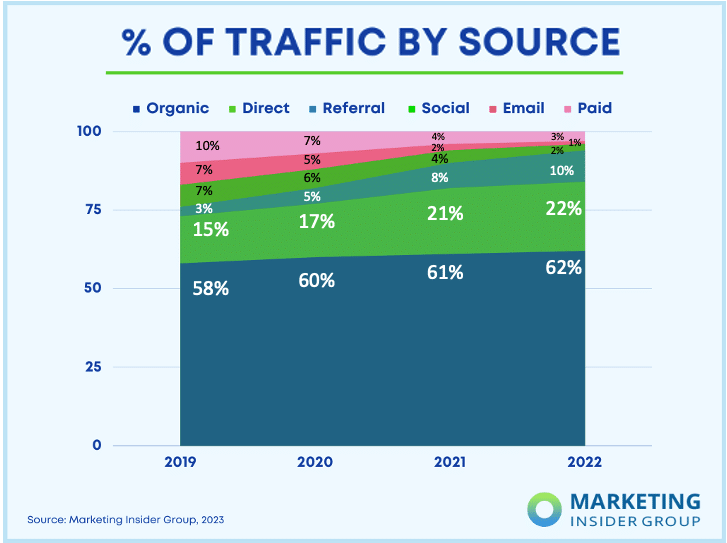
Companies aiming to expand their customer base and enhance conversions must prioritize digital marketing efforts. Surprisingly, 45% of businesses are unaware of their Return on Investment (ROI). The primary reason behind this lack of insight is the absence of tracking mechanisms for website traffic sources and lead generation. Consequently, organizations risk misallocation of resources and misconceptions about consumer behavior in the online sphere.
The Pitfall of Misguided Efforts
Often, businesses invest significant time, money, and resources in marketing channels like social media and paid searches without yielding substantial traffic, leads, or ROI. A common scenario involves a founder launching a product, establishing a website, and assembling a sales team. Subsequently, the addition of a social media intern or collaboration with a media agency for banner advertisements.
The Power of Organic Search
Research indicates that Organic Search remains a crucial driver of traffic and leads for most companies. Those focusing on content marketing to bolster organic traffic witness heightened conversion rates and improved ROI. Not only is content marketing cost-effective, but it also offers long-term benefits, cultivating brand authority and attracting genuinely interested buyers.
Exploring Paid Search
Paid search presents an alternative strategy with its swift results. However, sustaining these outcomes necessitates continued investment. Moreover, 94% of searchers bypass paid ads in favor of organic search results, underscoring the significance of organic traffic.
Insights from Website Traffic Sources Report
Key findings from the Website Traffic Sources report include:
- Organic search contributes to over 60% of web traffic
- More than two-thirds of top blogs' traffic originates from organic search
- Over 90% of website traffic stems from organic sources, encompassing Search, Referral, and direct traffic
- Paid search, email, and social media collectively contribute to less than 10% of web traffic
- B2B and B2C sectors exhibit similar patterns in web traffic sources
Maximizing Content Marketing ROI
To optimize content marketing ROI across diverse web traffic sources, two fundamental strategies are pivotal: leveraging Google Analytics to track site traffic and consistently producing high-value content tailored to the target audience.

Demystifying Web Traffic Sources
Exploring the primary web traffic sources utilized in digital marketing strategies:
- Direct Visitors: Users directly access the website without intermediary links
- Organic Search: Users navigate to the site through search engine results
- Social Media: Website visitors are directed through social media platforms
- Email: Traffic is generated via links in direct emails
- Paid Traffic: Traffic is acquired through digital display ads or paid search
The Dominance of Organic Search
Organic search emerges as the frontrunner in web traffic, constituting over 60% of overall traffic. This trend is consistent across industries, underscoring the critical role of organic search in driving website visits and leads.
Evolution of Web Traffic Sources
Recent data highlights the escalating significance of organic search, directing a surge in website traffic over the years. Conversely, the relevance of social, paid, and email traffic has dwindled, emphasizing the growing dominance of organic search as a primary traffic source.
Comparing B2B and B2C Traffic Sources
Despite the inherent disparities between B2B and B2C marketing approaches, both sectors exhibit a reliance on organic search as a predominant traffic source. This alignment challenges conventional assumptions regarding traffic generation strategies.
Insights from Industry Analysis
An industry-wide analysis underscores the prevalence of organic search as the primary driver of web traffic across diverse sectors. Noteworthy variations exist, with certain industries displaying heightened reliance on organic search compared to others.
Enhancing Conversion Rates
While average conversion rates hover around 2.5%, strategic initiatives and consistent execution can elevate conversion rates beyond the norm. Employing a multi-channel approach is essential to engage target audiences effectively and sustain lead generation.

Optimizing Web Traffic Sources
Utilizing tools like Google Analytics and WordPress plugins enables businesses to track web traffic effectively, facilitating informed decision-making and continuous refinement of digital marketing strategies based on audience behavior.
Empowering Success through Content
Compelling content serves as the linchpin for driving traffic across various sources, engaging new audiences, fostering trust with potential clients, and encouraging repeat visits. A robust content strategy, coupled with consistent publication schedules, is indispensable for navigating the digital marketing landscape.
Frequently Asked Questions
What are some direct marketing examples?
Direct Marketing Examples include postcards, brochures, flyers, e-mails, etc.
Direct marketing allows you to reach people wherever they are. Direct marketing is the best method to communicate with customers who have chosen your product over another brand.
You should know which message will appeal to your target market the most.
Finding out what your customers want is key to delivering it.
There are many ways to use direct marketing to promote your business. You could send potential customers catalogs or advertise in local newspaper.
A unique mailing list can be created from your existing customers. You can easily add subscribers to your existing customers list if there is a good database.
You can also ask current customers if you'd like to send them promotional materials. Sign up for special offers to receive discounts from some companies.
Are there any risks associated with digital marketing?
Yes, there are several risks involved in digital marketing.
You must first protect your online reputation through being cautious about what you share on social media.
You should also make sure that all your content is original.
In addition, you risk losing control of your brand image if you do not monitor your online presence closely.
If someone uses your information without permission, you could be at risk of identity theft.
How to Protect Your Online Image
- Be careful about what you share on social networks
- Ensure All Content Is Original And Does Not Infringe On Anyone Else's Intellectual Property Rights
- Monitor Your Brand Image
- Use Strong Passwords
- You should not use personal information without permission
- Notify us immediately of any unauthorized activity
- Don't Post Photos Of Yourself Or Others In A Disturbing Way
- Never divulge any Social Security Number
- Keep up with the latest news
- Avoid Scams
- Secure Password
- Always Check For Updates
- Don't share too many details
- Be Vigilant When Giving Out Credit Card Numbers
- Avoid sending money by E-Mail
- Beware of fake websites
- Remember That Bad Reviews Can Hurt Your Business
- Regularly check your credit reports
- Keep an eye on your privacy settings
- Ask someone who is familiar with you before sharing your thoughts.
What are the best digital marketing strategies that I can do from home?
Digital marketing can be a great way to reach customers who spend their most time online. This is also a great way to generate leads for you business.
You can use social media platforms like Facebook, Twitter, and LinkedIn to promote your brand. You can also make use of email marketing tools for sending emails to prospects and potential clients.
You can also market your product and service in digital media in many other ways.
As long as you know how to effectively use these channels, getting started should be no problem.
Social Media Marketing is a great way to promote your business online. It's a great way to build brand awareness and generate leads. Here are five methods to leverage social media marketing to increase your business.
- Make a Facebook fan page – This will allow you to interact directly on Facebook with your customers. You can also upload content such as photos, videos, and other files.
- Twitter: Promote your business – Twitter is another great place for information sharing and connecting with people. To increase visibility, use hashtags
- Post Videos on YouTube. Many people enjoy watching these videos. If people like what they see, they may click on your website.
- Host live events – Live events allow potential clients to meet you face-to–face. They will be able to ask questions about the products and services you offer.
- React to Customer Review – Positive reviews will build trust between you and your clients, which in turn will encourage repeat purchases. Negative comments should be addressed quickly.
Statistics
- Companies that use personalization are seeing revenue increases ranging from 6-10%. (blog.hubspot.com)
- A poll earlier this year found that 14% of older Gen Z's had bought an item in the previous six months based on an influencer's recommendation. (influencermarketinghub.com)
- Meanwhile, a PartnerPath poll found that co-marketed ads help 68% of consumers arrive at a buying decision before even speaking to a salesperson. (influencermarketinghub.com)
- 81% of brands employ affiliate marketing, and eCommerce sites are particularly good candidates. (blog.hubspot.com)
- This allows us to deliver CPCs that are 80% less than average and CTRs 4-5 times higher than average. (marketinginsidergroup.com)
External Links
blog.hubspot.com
neilpatel.com
influencermarketinghub.com
youtube.com
How To
20 Innovative Affiliate Marketing Strategies You Should Try in 2022
Affiliate marketing is one of the most effective ways to make money online. This is the easiest way to get started. First, sign up for an affiliate platform like Commission Junction. Then place links on your site or blog. The commission you receive when someone purchases from one of those links will earn you a commission.
These are 20 affiliate marketing techniques you should consider in 2022
- Create a Content Calendar
- Google Adwords
- Start Your Podcast
- Join A Blogging Network
- Make an email list
- Earn Cash for Reviews
- Get Influential
- Offer Free Trials
- Start a Membership Site
- Sell Products On Amazon
- Write articles
- Start a YouTube Channel
- Host Events
- Develop A Mobile App
- Promote Your Business Online
- Run Facebook Ads
- Register for a Twitter Account
- Grow Instagram Followers
- Be open with your customers
- Earn More Money In The Long Term
————————————————————————————————————————————–
By: 6610
Title: Understanding Web Traffic: Maximizing ROI with Effective Marketing Strategies
Sourced From: internetlib.org/where-did-your-website-traffic-originate-top-web-traffic-sources/
Published Date: 4/10/2023 5:40:45 PM
